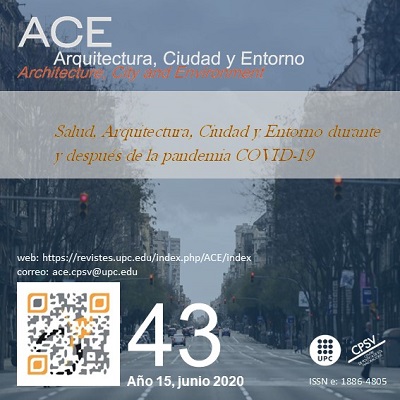Assessment of light performance in work environments, based on the non-visual effects of natural light on health
DOI:
https://doi.org/10.5821/ace.15.43.8903Keywords:
human factors, circadian lighting, ipRGCs, melatoninAbstract
The performance of natural light in indoor environments has been studied in terms of daylight autonomy and energy efficiency. The human factor is commonly excluded from the assessment variables. However, recent research confirms the relevance of taking advantage of natural light most of the day and its biological benefits regulating circadian rhythms; which reaffirms the need to incorporate these concepts into architectural design. This article proposes a weighting curve to estimate the light level in Equivalent Melanopic Lux (EML) for different ages, starting at 98.5% of melatonin suppression. In addition, it explores an evaluation method with computational simulations of office space and various architectural modifications; for users between 25 and 55 years old, using a climate file of the place and a metric of Daylight Autonomy (DA). The results obtained were compared with the concepts of circadian lighting of the WELL Certification and the studies of Kyle Konis, exposing a different perspective on the assessment of light performance and health effects in office environments according to age. This research demonstrates that it is possible to incorporate a descriptive method as a tool to broaden the panorama in more complete analyses of natural light in indoor environments, providing clues to spatial functionality in terms of well-being, health, and comfort. However, progress is still needed in human factor metrics and computational simulation tools to facilitate assessing health effects in architecture.
Downloads
Published
Issue
Section
License
| INTELECTUAL PROTECTION CRITERIA |
At this moment, it is count with the "Oficina Española de Patentes y Marcas", while global protection it is being processed by the World Intelectual Property Organization (OMPI/WIPO). Nevertheless the International Standard Serial Number Office (ISSN) has given the following numbers ISSN: 1886-4805 (electronic version) and 1887-7052 (paper version). All articles will be peer reviewed, using double blind reviewing. |
| COPYRIGHT |
The article contents and their comments are authors exclusive liability, and do not reflect necessarily the journal editor commitee's opinion. All ACE published works are subject to the following licence CC BY-NC-ND 3.0 ES http://creativecommons.org/licenses/by-nc-nd/3.0/es/ It implies that authors do not hold nor retain the copyright without restrictions but only those included in the licence. |


































